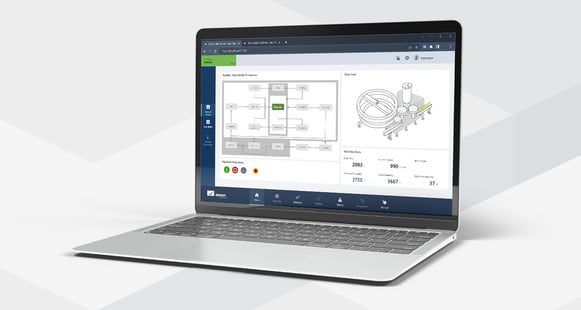zenon Web Visualization Service (WVS)
High-performance HMI & SCADA solution for web browsers

With the Web Visualization Service (WVS), COPA-DATA is laying the foundation for a comprehensive, in-depth integration of HTML5-based visualization for zenon Service Engine. Designed as a thin-client solution, zenon WVS enables you to view project content without additional installation on virtually any end-user device or operating system using an internet browser.
- Use with virtually any end user device or operating systems via web browser (Chrome, Firefox, Safari) without additional installation being necessary.
- Use of integration projects and subprojects.
- Direct project engineering in the Engineering Studio, no additional compiler necessary.
- AML/CEL with all filter options (without dialogs).
- Native integration in the Service Engine: enables extensive use of existing features.
How to use WVS
Project engineering takes place, as usual, in zenon Engineering Studio.
When you launch zenon Service Engine, you can choose either classic DirectX-Visualization or WVS. Start WVS directly from the Engineering Studio or via the Startup Tool and the visualization opens automatically in the standard browser. The visualization is then scaled automatically to the browser window. It also responds when you rotate your mobile device.
Features supported
Standard functions such as language switch, color switching, assignment of user authorizations, and the use of interlocking features are supported. Standard screens and selected special screen types can be used with zenon WVS. In addition, all zenon functionalities that do not require visualization are supported out of the box in WVS.
- Standard screens with all static screen elements and selected dynamic screen elements, including button, switch, dynamic text, numeric value, bar display, and pointer instrument. All elements listed also support visibility and blinking.
World-View support inclusive zooming and decluttering. - Faceplates: integration of other screen types that are supported in Faceplates and WVS
- Alarm Message List (AML): The AML is displayed with all columns available as well as alarms with live update (both from the ring buffer and historical or shelved entries) including coloring from Alarm or Event classes. Context can also be added to alarms using alarm causes or comments. You can filter the AML using the screen switch function (without dialogs).
- Chronological Event List (CEL): The CEL displays all events and associated comments. You can filter the CEL using the screen switch function (without dialogs).
- Extended Trend: The Extended Trend displays curves and Gantt curves with live updates including limit ranges and multiple axes.
- Recipegroup Manager (RGM): Edit, read and write recipes.
- Batch Control: Selection of Master recipes, Creation and Execution of Control recipes (no editor).
- Command for sending switching commands.
- Equipment model screen for filtering AML and CEL screens and executing linked functions.
- Screen keyboard for entering set values and in connection with RGM.
- Login screen for secure user login.
- HTML screen for embedding external media such as web pages or webcams.
- Multi-hierarchical project structure: Implement integration projects with multiple subprojects.
Multi-user access to WVS
zenon Web Visualization Service is multi-session capable and is designed as a thin-client solution. In addition to the encryption of the communication between zenon Service Engine and the browser, individual sessions are completely independent of each other. This enables, for example, the use of local internal variables on the WVS instance.
You can also optionally encrypt the communication between the zenon server and the instance of zenon Web Visualization Service (zenon client). The main access point for external devices (via a browser) is Web Visualization Service Ops Manager. It handles both the administration of the individual Web Visualization Service instances and the assignment of the browser sessions to the instances. This can be configured conveniently via a web interface.
To access WVS as a remote user, all you need to do is enter a single URL in your browser. To meet increased security requirements for applications used purely for monitoring, you can opt to operate WVS clients in read-only mode. Mixed operation of read/write and read-only on the same computer is not possible. In this case, you will need to install two WVS Ops Managers on two separate machines, each with its own license.

Figure 1: Session management with the WVS Ops Manager